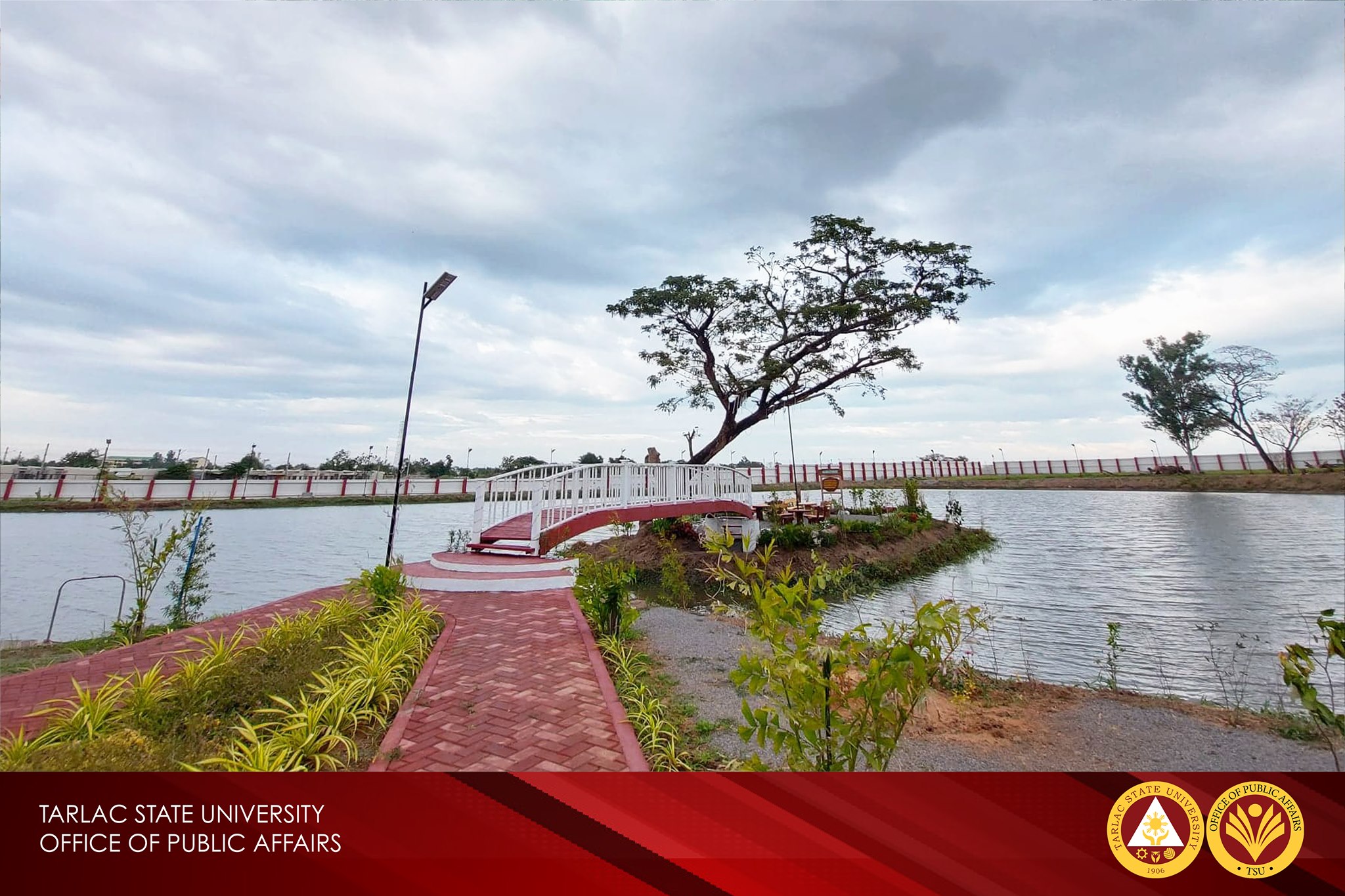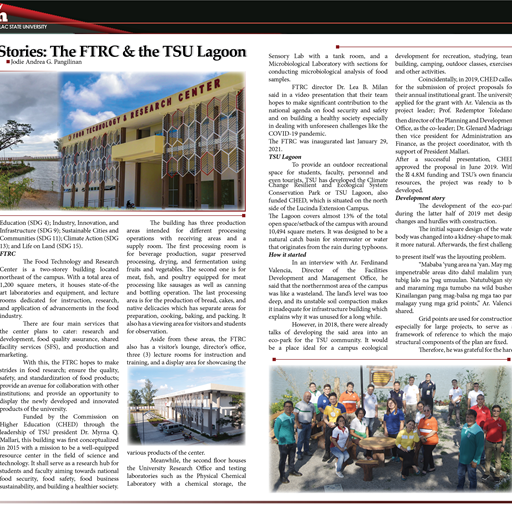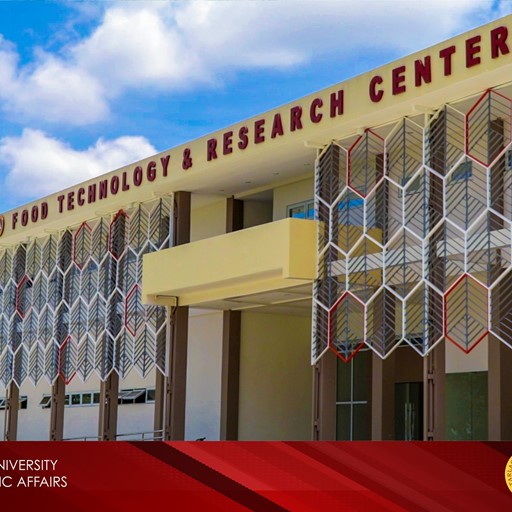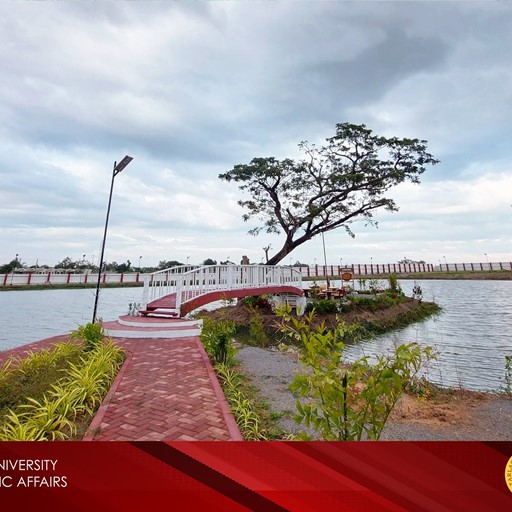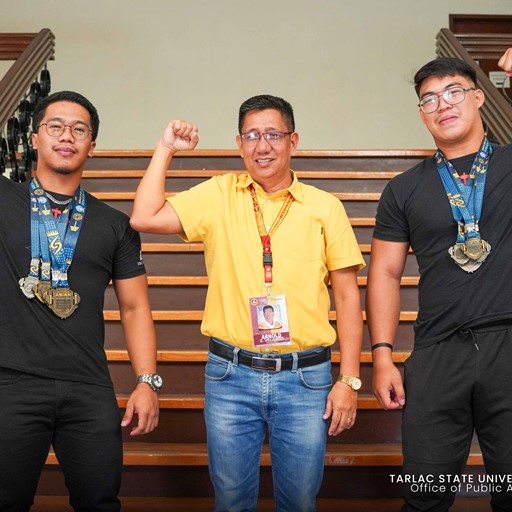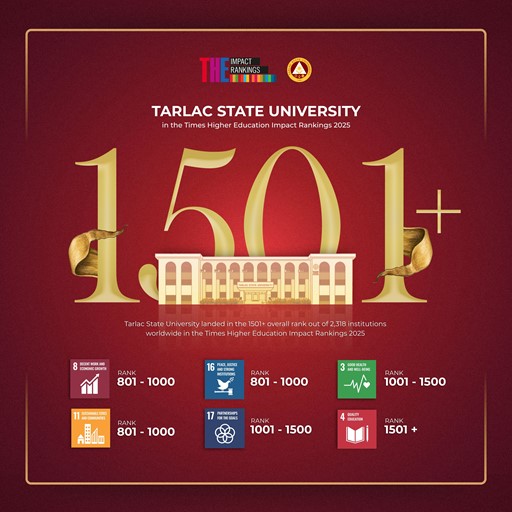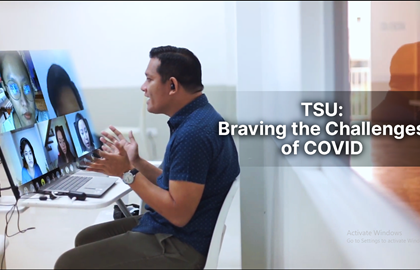Tarlac State University continuously strives to attain its vision of becoming a premier university in the Asia Pacific Region. Included in this endeavor is the development of infrastructure and open spaces that will provide the ideal environment for learning, research, and recreational activities.
For this year, two major projects have come into fruition through the collaborative effort and determination of the TSU community and partner government agencies. These are the Food Technology and Research Center (FTRC) and the TSU Climate Change Resilient and Ecological System Conservation Park, fondly called “TSU Lagoon,” which are both located at the TSU Lucinda Extension Campus.
The development and improvement of the FTRC and the Lagoon is also in line with the university’s compliance to the Sustainable Development Goals (SDG) of the United Nations which include Zero Hunger (SDG 2); Good Health and Well-being (SDG 3); Quality Education (SDG 4); Industry, Innovation, and Infrastructure (SDG 9); Sustainable Cities and Communities (SDG 11); Climate Action (SDG 13); and Life on Land (SDG 15).
FTRC
The Food Technology and Research Center is a two-storey building located northeast of the campus. With a total area of 1,200 square meters, it houses state-of-the art laboratories and equipment, and lecture rooms dedicated for instruction, research, and application of advancements in the food industry.
There are four main services that the center plans to cater: research and development, food quality assurance, shared facility services (SFS), and production and marketing.
With this, the FTRC hopes to make strides in food research; ensure the quality, safety, and standardization of food products; provide an avenue for collaboration with other institutions; and provide an opportunity to display the newly developed and innovated products of the university.
Funded by the Commission on Higher Education (CHED) through the leadership of TSU president Dr. Myrna Q. Mallari, this building was first conceptualized in 2015 with a mission to be a well-equipped resource center in the field of science and technology. It shall serve as a research hub for students and faculty aiming towards national food security, food safety, food business sustainability, and building a healthier society.
The building has three production areas intended for different processing operations with receiving areas and a supply room. The first processing room is for beverage production, sugar preserved processing, drying, and fermentation using fruits and vegetables. The second one is for meat, fish, and poultry equipped for meat processing like sausages as well as canning and bottling operation. The last processing area is for the production of bread, cakes, and native delicacies which has separate areas for preparation, cooking, baking, and packing. It also has a viewing area for visitors and students for observation.
Aside from these areas, the FTRC also has a visitor’s lounge, director’s office, three (3) lecture rooms for instruction and training, and a display area for showcasing the various products of the center.
Meanwhile, the second floor houses the University Research Office and testing laboratories such as the Physical Chemical Laboratory with a chemical storage, the Sensory Lab with a tank room, and a Microbiological Laboratory with sections for conducting microbiological analysis of food samples.
FTRC director Dr. Lea B. Milan said in a video presentation that their team hopes to make significant contribution to the national agenda on food security and safety and on building a healthy society especially in dealing with unforeseen challenges like the COVID-19 pandemic.
The FTRC was inaugurated last January 29, 2021.
TSU Lagoon
To provide an outdoor recreational space for students, faculty, personnel and even tourists, TSU has developed the Climate Change Resilient and Ecological System Conservation Park or TSU Lagoon, also funded CHED, which is situated on the north side of the Lucinda Extension Campus.
The Lagoon covers almost 13% of the total open space/setback of the campus with around 10,494 square meters. It was designed to be a natural catch basin for stormwater or water that originates from the rain during typhoons.
How it started
In an interview with Ar. Ferdinand Valencia, Director of the Facilities Development and Management Office, he said that the northernmost area of the campus was like a wasteland. The land’s level was too deep, and its unstable soil compaction makes it inadequate for infrastructure building which explains why it was unused for a long while.
However, in 2018, there were already talks of developing the said area into an eco-park for the TSU community. It would be a place ideal for a campus ecological development for recreation, studying, team building, camping, outdoor classes, exercises, and other activities.
Coincidentally, in 2019, CHED called for the submission of project proposals for their annual institutional grant. The university applied for the grant with Ar. Valencia as the project leader; Prof. Redemptor Toledano, then director of the Planning and Development Office, as the co-leader; Dr. Glenard Madriaga, then vice president for Administration and Finance, as the project coordinator, with the support of President Mallari.
After a successful presentation, CHED approved the proposal in June 2019. With the ₱ 4.8M funding and TSU’s own financial resources, the project was ready to be developed.
Development story
The development of the eco-park during the latter half of 2019 met design changes and hurdles with construction.
The initial square design of the water body was changed into a kidney-shape to make it more natural. Afterwards, the first challenge to present itself was the layouting problem.
“Mababa ‘yung area na ‘yan. May mga impenetrable areas dito dahil malalim yung tubig lalo na ‘pag umuulan. Natutubigan siya and maraming mga tumubo na wild bushes. Kinailangan pang mag-balsa ng mga tao para malagay yung mga grid points,” Ar. Valencia shared.
Grid points are used for construction, especially for large projects, to serve as a framework of reference to which the major structural components of the plan are fixed.
Therefore, he was grateful for the hard work exhibited by the teams of Mr. Ronnie Vitug, head of the Facilities Maintenance Unit, for installing the grid points; Mr. Jimmy Vasquez, head of the Janitorial and Grounds Services Unit, for the clearing operations; and Engr. Ryan Layug, head of the Planning and Monitoring Unit, for the engineering design details.
The land softens whenever it rains which became a problem during the development phase. It was then difficult for heavy equipment, such as bulldozers, to operate.
Future Actions
As of this writing, the Lagoon’s development phase is already complete. However, there are still rooms for improvement to make it more aesthetic and ecologically efficient.
A project with the TSU Alumni Association Inc. has been completed recently where they beautified the islet found in the middle of the waters. The islet or the “Alumni Park” now has several shrubs, benches, and an improved bridge that connects it to the mainland.
Birds, such as the Little Egret and Collared Kingfisher, have already paid a visit to the Lagoon. TSU is currently developing the project into a bird sanctuary which is consistent with its purpose on ecological conservation.
The university now plans to increase the flora of the area by re-grading its shorelines with gentler slopes and adding more indigenous plant species to provide shelter and food sources for migratory and urban birds.
This project was proposed by Prof. Bertrand Aldous Santillan and his team supported by the College of Science.
When asked about other developments, Ar. Valencia says they are still planning to build a gazebo, a water treatment facility, and a drainage line towards the Masalasa Creek for water overflow.
“Ang concept namin nina Sir Ted [Prof. Toledano], we’d like the Lagoon – the eco-park to be as natural as it can be. We want to have a nature or sanctuary in Lucinda – to have a place to relax, to hold physical activities like walking, jogging, or possibly fishing,” said Ar. Valencia.
“The project materialized with the hard work of those who were involved — with the leadership of Dr. Myrna Mallari, the leadership of Sir Glenard, the proposal of Sir Ted, and the execution of our office,” he added.
